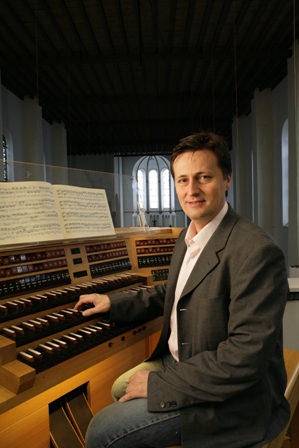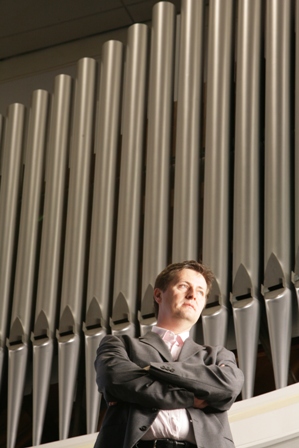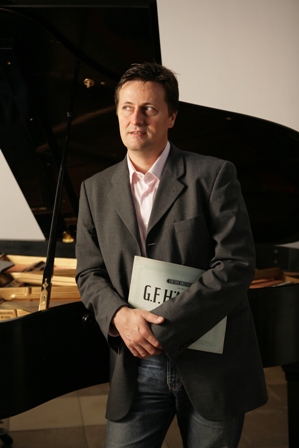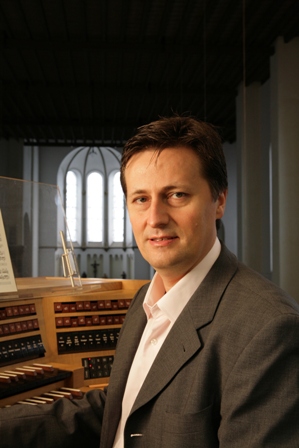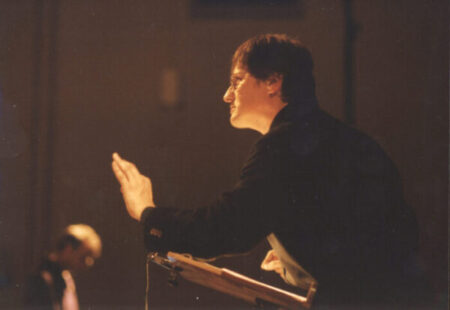Silent Film Music: The Man at the Piano and Organ
History – Written Accounts and Speculations
Since films have been publicly shown, music has accompanied them (at the first screening of the Lumière brothers’ films in 1895 in Paris, a pianist is said to have played). It is also quite certain that the use of music not only had the task of eliminating disruptive factors (projector noise, covering the “outside noise” in non-isolated spaces, unrest in the audience, as well as “calming” anxious viewers, who had to sit in completely darkened rooms due to the still weak projection), but it was also meant to build atmosphere, intensify impressions, and launch emotions.
It seems particularly true for the period before 1900 that great importance was placed on selecting appropriate music that would enhance the illusion and reality experience. After 1900, according to various accounts, any music, preferably popular, would suffice, meaning that the fact of musical accompaniment itself gained importance.
In addition, pianists and organists (as early as 1896, an organist is said to have accompanied the London premiere of Lumière’s films on a harmonium—one with three missing notes) naturally relied on existing literature—primarily 19th-century piano music (following the tradition of “Songs Without Words” / Mendelssohn / Schumann / Grieg / Salon Music)—whose short character pieces often matched the mood of early film character portraits. What else could they do, given the long hours spent in cinemas (often from late morning until 11 pm, uninterrupted), constantly changing programs, minimal preparation time, and of course, the lack of specialized literature?
The longer the films became and as the emerging feature film with its dynamic discontinuity of the story, broken into individual scenes, required a continuous musical thread to bind contrasting scenes and shots, the more film music developed into an independent art form.
As early as 1910, American trade publications regularly offered tips on accompanying current films (it is worth noting that the French production group “Film d’Art” had already engaged Camille Saint-Saëns in 1908 for an original orchestral score for their one-act film L’Assassinat du Duc de Guise).
From 1912 onward, so-called “cue sheets” were created: music lists precisely aligned with the film’s progression. The path from perfecting “cue sheets,” listing musical characters, cataloging appropriate titles for those characters (compilation), to composing transitions and linkages (composition), and finally creating a piano score that no longer relied on pre-existing elements (work-related original composition), is easy to trace.
Even in an era of growing original music for large orchestras, the pianist/cinema organist maintained an important role: especially in the provinces, where, playing from a piano reduction, they mimicked the orchestra that was not available due to financial constraints.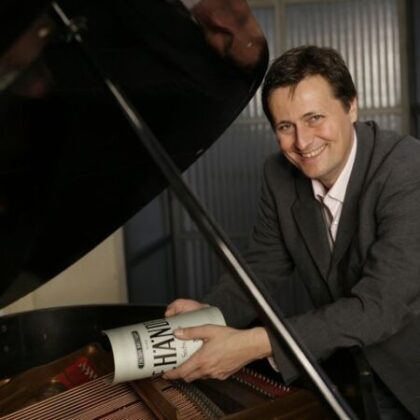 But even in large cinema palaces, the piano or cinema organ would take over the missing instruments of the orchestra; the organ would also provide instrumental balance for often unevenly distributed ensembles (too few strings with too many brass instruments due to necessary instrumentation) and also regulate volume changes. Furthermore, the organist, with the cinema organ—richly equipped with effects—would accompany entire film screenings because the orchestra could not manage five or six two-hour sessions daily. However, the “man at the piano” scarcely survived the trend toward luxury in the grand “picture palaces” built from around 1920. For instance, the New York “Roxy” (1927) included an orchestra of 110 musicians, four conductors, three organists, a mixed choir, and a group of high-caliber vocal soloists.
But even in large cinema palaces, the piano or cinema organ would take over the missing instruments of the orchestra; the organ would also provide instrumental balance for often unevenly distributed ensembles (too few strings with too many brass instruments due to necessary instrumentation) and also regulate volume changes. Furthermore, the organist, with the cinema organ—richly equipped with effects—would accompany entire film screenings because the orchestra could not manage five or six two-hour sessions daily. However, the “man at the piano” scarcely survived the trend toward luxury in the grand “picture palaces” built from around 1920. For instance, the New York “Roxy” (1927) included an orchestra of 110 musicians, four conductors, three organists, a mixed choir, and a group of high-caliber vocal soloists.
Silent Film Practice Today – A Personal Perspective
Comparisons of film archives show that during the silent film era, different musical practices existed and succeeded one another. Moreover, attempts (which are sometimes quite successful) to reconstruct compiled film music often fail due to a series of problems:
- Sheet music and compilation lists are rarely available or accessible (often due to poor archiving and lack of interest from film companies due to the lack of economic incentive).
- Compilation lists rarely match the existing, mostly fragmented film copies.
- Usually, perhaps only 20% of the music used is still available today.
- Piano reductions are often incomplete or riddled with mistakes, inaccuracies, and imprecise information (as they were often made for a specific performance or premiere).
- At live performances, the problem of projection speed arises: some cinemas lack equipment capable of projecting at less than the current standard of 24 frames per second. This immediately renders the score irrelevant (and causes significant stress for me as the ensemble leader).
- Music can only be created for a specific copy, as no two silent film versions are identical (I’ve frequently encountered problems when scenes appeared in a film that were completely unknown to me in terms of content and especially length). Performing alone (piano/organ) removes synchronization problems with other musicians.
When developing silent film music, I always consider several factors:
- Film content, film genre: Is it a wild slapstick or a socially critical documentary?
- Creation time: A hand-colored magic film by G. Méliès has different “roots in thinking” than a revolutionary film by S. Eisenstein, which also demands a fundamentally different approach to music.
- Director, film language, integration into the development of a director’s or directing team’s film concept: For an Asta Nielsen melodrama, I once set music as a stylistic guideline that the “man at the piano” might have played in the 27th screening in a rural cinema in 1920. In contrast, for abstract O. Fischinger films, I used a graphics program to process images from the film and transform them into synthetic musical sounds, with a computer controlling multiple synthesizers. For C. Th. Dreyer’s films shot in Scandinavia, for example, I relied on music by Edvard Grieg (Prästankan).
- Organizational and local requirements: For a VHS screening on the theme “Film Art – Visual Pleasure” for film scholars, for example, I was required to demonstrate different methods of silent film accompaniment within the program (on different films, of course).
- Additionally, during live performances, and especially during improvisation (composing on the spot), I always respond to the audience. The combination of composed (both original and found) material and improvisation, which allows for a particularly rapid reaction, characterizes my film music. The thematic and harmonic range spans from stylistic imitation to complete alienation of instrumental sounds.
This naturally requires an intensive engagement with film, literature, and music (from developing the overall structure of the music to the shaping of individual elements and long hours of practice on the instrument—achieving a unified sound, transposing themes, etc.).
Not only in longer films do I find it important to vary the perspective of the music to avoid becoming monotonous. Sometimes the action should be accompanied, sometimes paraphrased, the development hinted at, or the images contrapuntally highlighted (for example, the fiery death sequence of Jeanne d’Arc is underscored with very calm music—the choral theme from the Requiem “Paradise will guide you the angels…”—reflecting the certainty of the hope of salvation).
It is also possible to follow the editing rhythm of the sequences (during the long final sequence in Hitchcock’s The Lodger, a manhunt, the key of the motif and its tone color (register/organ stops) change with each camera shot to increase the tension).
Furthermore, it is possible to instrumentally clarify the various sensory layers of the film (for example, traditional major/minor harmony could sketch the atmosphere of a simple rural home, while the evil stranger brings with him late-romantic harmony, enriched with dissonances) or even present “film music as such” (e.g., with a title melody).
Recommendations – Perhaps a bit more personal
On such a limited number of pages, neither can the history of silent film music be presented in a way that resists scientific scrutiny, nor can a composer clearly convey his many hours of developed and multifaceted thoughts on scoring.
Therefore, it is important for me to share that through my intensive engagement with silent films—both significant and lesser-known—I have developed considerable respect for this medium over the past 20 years. Hopefully, most of the public already knows that silent film is not just “Laurel and Hardy,” but my thesis is that cinematic art and visual language reached a peak toward the end of the silent film era that is still rarely surpassed today, and this should motivate future exploration of silent film artworks.
Here are some—selectively, but not arbitrarily—initial recommendations (besides the well-known films like Caligari, Napoleon, Nosferatu, Metropolis, Battleship Potemkin, Goldrush…):
C. Th. Dreyer: Prästankan (1920); K. H. Martin: Von Morgens bis Mitternacht (1920); F. Lang: Der müde Tod (1921); W. Ruttmann: Opus 1-4 (1922-25); L. Kuleshov: Die seltsamen Abenteuer des Mr. West im Lande der Bolschewiki (1924); F. W. Murnau: Der letzte Mann (1924); H. Tintner: Cyankali (1930).


